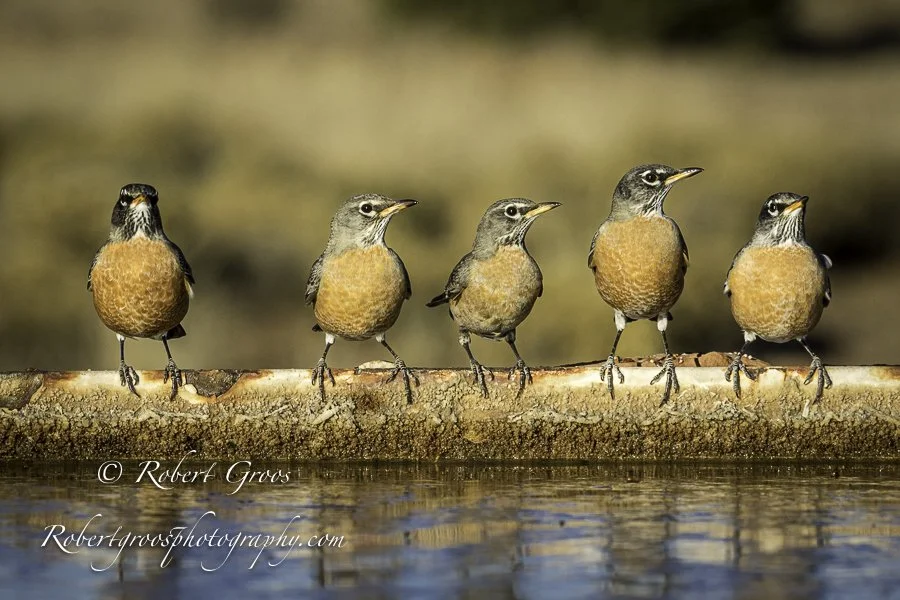Robin, Red Robin, American Robin
American Robin with a mouthful of earthworms
Think back to when you were a child. Picture yourself looking out across the lawn from your living room window, or playing on the grass at your neighborhood park. Your eyes are focused upon a round-bodied bird with an orange-red breast, a dark blue-gray head and back, hopping across the lawn. Stopping momentarily and standing proud, the bird cocks its head to the side as if carefully listening for a nearby sound. Suddenly, the bird stabs at the ground and pulls out a long, fat, juicy earthworm. And you, young child, you cry out with glee at this wondrous scene. Who in America doesn’t instinctively know that bird is an American Robin ?
How many worms does an American Robin eat in an average day? I did a Google search. Imagine, for a moment, a large bowl piled high with spaghetti spilling out over the edges. Might all that pasta strung end to end reach fourteen feet? Turn those noodles into earthworms, and that’s what your American Robin might ingest on an average day during spring and summer when earthworms are in abundance.
Just how is our robin able to accomplish this feat? While this thrush family member has very good hearing and a strong sense of smell, acute vision is what most likely enables it to find a meal. Unlike us, who look forward with both eyes, the robin’s monocular vision results in that iconic head posture we all recognize. With one eye aimed downward, robins can detect the slightest movement in the grass, or a minute disturbance on the surface of the ground. That is how our beloved early bird gets the worm.
American Robin looking for worms
American Robins (Turdus migratorius) are found across most of the United States, parts of Canada, and down into Mexico. Tolerant of human presence, the annual return of these iconic American songbirds to places where they do not overwinter heralds the coming of spring. Their number is estimated at well over 300 million, and their abundance in a particular location is considered to be indicative of the health of the surrounding ecosystem.
The Iroquois culture around Lake Ontario in New York State recounts a legend of how a little white bird befriended a man in need, and in so doing became the bird we now call Robin Redbreast, as told below:
During the Moon of the Falling Leaves, a band of hunters set out on a moose hunt to provision their families for the oncoming winter. Since they travelled far from home, they built a cabin warmed by fire for shelter. Day after day, the hunt was unsuccessful. Lacking food, one by one the hunters passed away until only a single man remained.
Weakened by lack of sustenance, this lone hunter could no longer tend to the fire, which he realized would soon become extinguished. Knowing that he would undoubtedly freeze to death, the man called out for help.
There was a little white bird nearby who heard the plea, and it flew into the shelter to offer help. First, the little bird fanned the coals with its wings, and then flew out to find some twigs. It made several trips, returning each time with more twigs until the fire was flaming hot.
Unknown to the bird, proximity to the flame singed its breast feathers, turning them a reddish orange hue. Nonetheless, the little bird did not mind because he was happy to rescue a dying man.
Revitalized by the warmth of the fire, and heartened by the cheerful song of the little bird, the hunter regained enough strength to go on a successful hunt, and became well and strong again. As the hunter began his journey home, the little bird hopped alongside. He bade the hunter farewell, saying he had to fly south because winter was coming soon. He promised to return in the spring and make its nest close to the lodges of men.
When spring arrived, the little bird returned with his mate, and built a nest close to the hunter’s lodge. Five little birds hatched in that nest, and they all had red breasts. Ever since, Robin Redbreast has continued to come and build his nest close to the lodges of men, for Robin Redbreast is a friend to man.*
American Robins at water tank
In recognition of Earth Day 2022, amidst dire predictions of the devastating effects of human-caused climate change, may this heartwarming allegorical tale, replete with meaning for our life and times, inform us in the decisions we make about the environment. More than ever before, the success of mankind is intricately tied to the well-being of the natural world that surrounds us.
If you enjoyed this post, please share the link with your friends. To be added to my mailing list for future articles, contact me at: robertgroos1@gmail.com. Your information will not be shared, and you can unsubscribe at anytime. Thank you.
my abbreviated version of “How the Robin burned his breast, ” as retold at Wisperingbooks.com.








